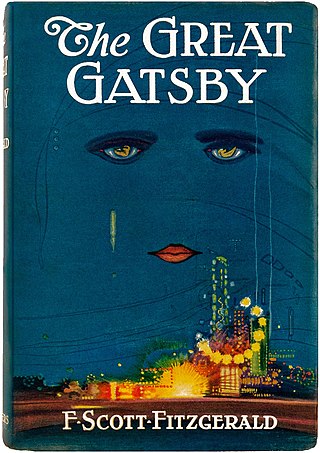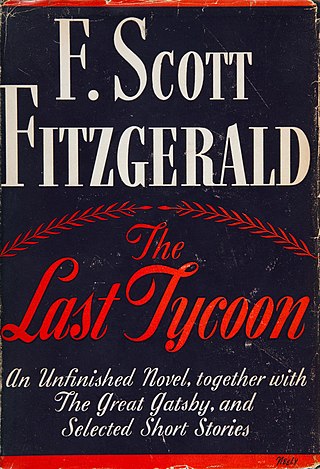Related Research Articles

The Great Gatsby is a 1925 novel by American writer F. Scott Fitzgerald. Set in the Jazz Age on Long Island, near New York City, the novel depicts first-person narrator Nick Carraway's interactions with mysterious millionaire Jay Gatsby and Gatsby's obsession to reunite with his former lover, Daisy Buchanan.

Zelda Fitzgerald was an American novelist, painter, playwright, and socialite. Born in Montgomery, Alabama, to a wealthy Southern family, she became locally famous for her beauty and high spirits. In 1920, she married writer F. Scott Fitzgerald after the popular success of his debut novel, This Side of Paradise. The novel catapulted the young couple into the public eye, and she became known in the national press as the first American flapper. Due to their wild antics and incessant partying, she and her husband became regarded in the newspapers as the enfants terribles of the Jazz Age. Alleged infidelity and bitter recriminations soon undermined their marriage. After traveling abroad to Europe, Zelda's mental health deteriorated, and she had suicidal and homicidal tendencies which required psychiatric care. Her doctors diagnosed Zelda with schizophrenia, although later posthumous diagnoses posit bipolar disorder.

The Last Tycoon is an unfinished novel by F. Scott Fitzgerald. In 1941, it was published posthumously under this title, as prepared by his friend Edmund Wilson, a critic and writer. According to Publishers Weekly, the novel is "generally considered a roman à clef", with its lead character, Monroe Stahr, modeled after film producer Irving Thalberg. The story follows Stahr's rise to power in Hollywood, and his conflicts with rival Pat Brady, a character based on MGM studio head Louis B. Mayer.
Matthew Joseph Bruccoli was an American professor of English at the University of South Carolina. He was the preeminent expert on F. Scott Fitzgerald. He also wrote about other writers, notably Ernest Hemingway, Thomas Wolfe and John O'Hara, and was editor of the Dictionary of Literary Biography.

Save Me the Waltz is a 1932 novel by American writer Zelda Sayre Fitzgerald. It is a semi-autobiographical account of her early life in the American South during the Jim Crow era and her tempestuous marriage to novelist F. Scott Fitzgerald. She composed the work while a patient at Johns Hopkins Hospital's Phipps Clinic in Baltimore, Maryland. As part of her recovery routine, she spent at least two hours a day writing a novel. She sent the manuscript to her husband's editor, Maxwell Perkins. Although unimpressed by the manuscript, Perkins published the work in order for Fitzgerald to repay his financial debt to his publisher Scribner's.

This Side of Paradise is the debut novel by American writer F. Scott Fitzgerald, published in 1920. It examines the lives and morality of carefree American youth at the dawn of the Jazz Age. Its protagonist, Amory Blaine, is an attractive middle-class student at Princeton University who dabbles in literature and engages in a series of romances with flappers. The novel explores the theme of love warped by greed and status-seeking, and takes its title from a line of Rupert Brooke's poem Tiare Tahiti.

Tender Is the Night is the fourth and final novel completed by American writer F. Scott Fitzgerald. Set in French Riviera during the twilight of the Jazz Age, the 1934 novel chronicles the rise and fall of Dick Diver, a promising young psychiatrist, and his wife, Nicole, who is one of his patients. The story mirrors events in the lives of the author and his wife Zelda Fitzgerald as Dick starts his descent into alcoholism and Nicole descends into mental illness.

The Short Stories of F. Scott Fitzgerald is a compilation of 43 short stories by F. Scott Fitzgerald. It was edited by Matthew J. Bruccoli and published by Charles Scribner's Sons in 1989. It begins with a foreword by Charles Scribner II and a preface written by Bruccoli, after which the stories follow in chronological order of publication.

Babylon Revisited and Other Stories is a collection of ten short stories written between 1920 and 1937 by F. Scott Fitzgerald. It was published in 1960 by Charles Scribner's Sons.

"Winter Dreams" is a short story by F. Scott Fitzgerald that was first published in Metropolitan magazine in December 1922 and later collected in All the Sad Young Men in 1926. The plot concerns the attempts by a young man to win the affections of an upper-class woman. The story, frequently anthologized, is regarded as one of Fitzgerald's finest works "for poignantly portraying the loss of youthful illusions."

Nick Carraway is a fictional character and narrator in F. Scott Fitzgerald's 1925 novel The Great Gatsby. The character is a Yale University alumnus from the American Midwest, a World War I veteran, and a newly arrived resident of West Egg on Long Island, near New York City. He is a bond salesman and the neighbor of enigmatic millionaire Jay Gatsby. He facilitates a sexual affair between Gatsby and his second cousin, once removed, Daisy Buchanan which becomes one of the novel's central conflicts. Carraway is easy-going and optimistic, although this latter quality fades as the novel progresses. After witnessing the callous indifference and hedonism of the idle rich during the riotous Jazz Age, he ultimately chooses to leave the eastern United States forever and returns to the Midwest.

Francis Scott Key Fitzgerald was an American novelist, essayist, and short story writer. He is best known for his novels depicting the flamboyance and excess of the Jazz Age—a term he popularized in his short story collection Tales of the Jazz Age. During his lifetime, he published four novels, four story collections, and 164 short stories. Although he achieved temporary popular success and fortune in the 1920s, Fitzgerald received critical acclaim only after his death and is now widely regarded as one of the greatest American writers of the 20th century.

Ginevra King Pirie was an American socialite and heiress. As one of Chicago's "Big Four" debutantes during World War I, she inspired many characters in the novels and stories of writer F. Scott Fitzgerald; in particular, the character of Daisy Buchanan in The Great Gatsby. A 16-year-old King met an 18-year-old Fitzgerald at a sledding party in Saint Paul, Minnesota, and they shared a passionate romance from 1915 to 1917.

All the Sad Young Men is the third collection of short stories written by F. Scott Fitzgerald, published by Scribners in February 1926.

Taps at Reveille (1935) is a collection of 18 short stories by F. Scott Fitzgerald. It was the fourth and final collection of short stories Fitzgerald published in his lifetime. All were timed to appear a few months to a year after each of his four completed novels were published.

The Basil and Josephine Stories is a collection of two separate short stories collections by F. Scott Fitzgerald which initially ran serially in The Saturday Evening Post. Some of them were later collected in Taps at Reveille and posthumous short story collections. The title characters were intended by Fitzgerald to meet each other, but this never happened in his literature.
"First Blood" is a short story by F. Scott Fitzgerald, originally published in the April 5, 1930 issue of The Saturday Evening Post, illustrated by Harry Russell Ballinger. It was later included in his 1935 short story collection Taps at Reveille.

"The Rich Boy" is a short story by American writer F. Scott Fitzgerald. It was included in his 1926 collection All the Sad Young Men. "The Rich Boy" originally appeared in two parts, in the January and February 1926 issues of Redbook. In the January installment, the story is described on the front cover as: "A great story of today's youth by F. Scott Fitzgerald".

Francis Scott Key Fitzgerald was an American author of novels and short stories, whose works are the paradigmatic writings of the Jazz Age. He is widely regarded as one of the greatest American writers of the 20th century. Fitzgerald is considered a member of the "Lost Generation" of the 1920s. He finished four novels: This Side of Paradise, The Beautiful and Damned, The Great Gatsby, and Tender Is the Night. A fifth, unfinished novel, The Last Tycoon, was published posthumously. Fitzgerald also wrote many short stories that treat themes of youth and promise along with age and despair.
"Absolution" is a short story by American writer F. Scott Fitzgerald. It was included in his 1926 collection All the Sad Young Men.
References
- ↑ Edith Walton, "Scott Fitzgerald's Tales," The New York Times, March 31, 1935
- The stories of F. Scott Fitzgerald: a selection of 28 stories FS Fitzgerald, M Cowley - 1951 - Scribner